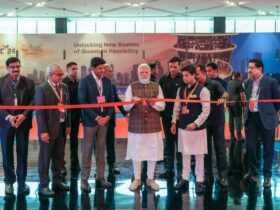These supercomputers, developed indigenously at a cost of Rs 130 crore, have been deployed in Pune, Delhi and Kolkata to promote frontier research in several scientific disciplines.
Prime Minister Narendra Modi today (Thursday, September 26) launched three PARAM Rudra supercomputers, built with indigenous technology. The move is a significant milestone in scientific and technological advancement under the National Supercomputing Mission (NSM). The supercomputers cost Rs 130 crore. The Prime Minister dedicated these three supercomputers to the nation through video conferencing this evening. These indigenously developed supercomputers have been deployed in Pune, Delhi and Kolkata to promote frontier research in several scientific disciplines.
On this occasion, the Prime Minister said that a country can aim for big achievements only when it has a big vision. He emphasized that technology upgradation should be to empower the poor. He also inaugurated a high performance computing (HPC) system designed for weather and climate research. Modi said that today’s India is creating new opportunities in the infinite sky of possibilities.
The Prime Minister said that his government has taken steps to ensure that research in technology benefits the common man. He said, “The significance of science is not only in invention and development, but also in fulfilling the hopes and aspirations of the last person. Today, if we are going hi-tech, then we are also ensuring that our hi-tech technology becomes the strength of the poor.”
National Supercomputing Mission launched in 2015
He said, “Once upon a time, only a few countries were considered to have expertise in supercomputers. We started the National Supercomputing Mission in 2015 and today India is competing with big countries in the field of supercomputers. We are not going to stop here.” He said, “India is already leading in technologies like quantum computing. Our National Quantum Mission will play a big role in taking India forward in this field. This new technology is going to completely change our world in the coming times. This will bring unprecedented changes and create new opportunities in the IT sector, manufacturing, industry, MSME and startup sector.”
Modi said his government was giving priority to science, technology and research. “Preparations for Mission Gaganyaan have begun and by 2035 we will have our own space station,” he said, adding that the first phase of the project has been approved. “Self-reliance through research is our mission,” Modi said. The prime minister was earlier scheduled to inaugurate these projects from Pune but his visit was cancelled due to heavy rains in Maharashtra.
What are its features and what will it do?
According to the Prime Minister’s Office (PMO), three PARAM Rudra supercomputers have been built in line with the commitment to make India self-reliant in the field of supercomputing technology. These supercomputers have been installed in Pune, Delhi and Kolkata for leading scientific research. The supercomputer will be used to detect the Giant Meter Radio Telescope (GMRT) in Pune, Fast Radio Burst (FRB) and other astronomical events.
The Inter University Accelerator Centre (IUAC) in Delhi will promote research in areas such as materials science and nuclear physics while the SN Bose Centre in Kolkata will promote advanced research in areas such as physics, cosmology and earth sciences.
Big progress in weather and climate research too
The Prime Minister inaugurated a high performance computing (HPC) system designed for weather and climate research, built with an investment of Rs 850 crore. According to the PMO, this project is a significant step in India’s computing capabilities for meteorological applications. The PMO said that this HPC system located at two major sites – Indian Institute of Tropical Meteorology (IITM) in Pune and National Center for Medium Range Weather Forecasting (NCMRWF) in Noida has extraordinary computing power.
The new HPC systems have been named ‘Arka’ and ‘Arunika’, indicating their relation to the Sun. These high-resolution models will significantly enhance the accuracy and lead time of predictions of tropical cyclones, heavy rainfall, thunderstorms, hailstorms, heat waves, droughts and other important meteorological events.













Leave a Reply